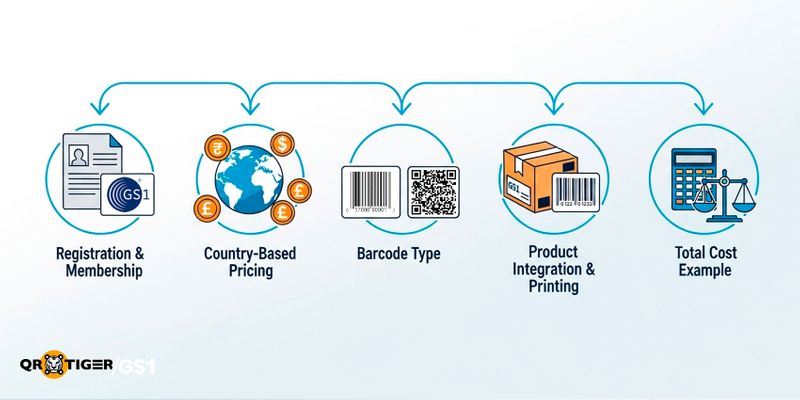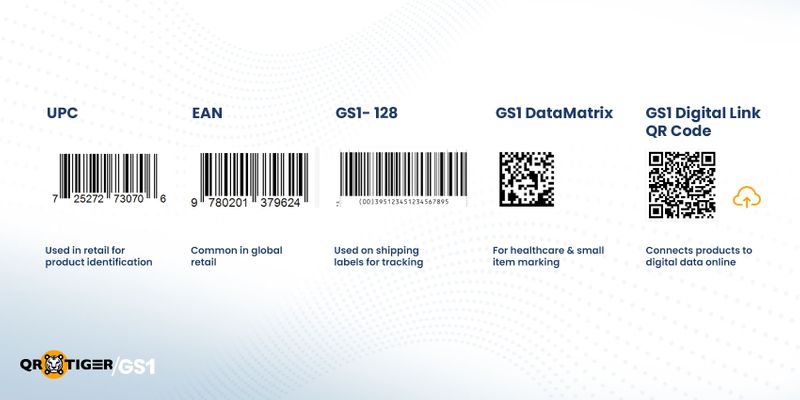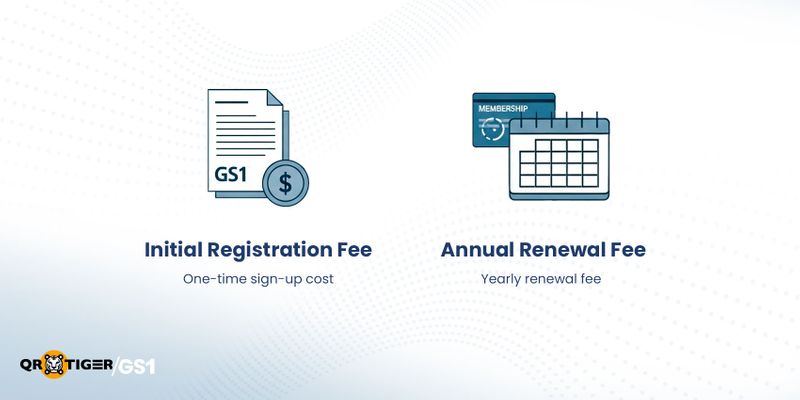How much does GS1 Barcode Cost?

GS1 barcodes are unique identifiers that encode information about products, shipments, and locations. These machine-readable symbols are managed by GS1, a global non-profit organization that defines standards for business communication.
They ensure product traceability, authenticity, and compatibility across the supply chain. GS1 standards enable accurate tracking from production to point-of-sale. These barcodes ensure authenticity by providing globally unique identifiers and enabling product verification.
They are accepted by major retailers, e-commerce platforms, and logistics providers globally, ensuring effective integration across systems.
This blog discusses who needs these barcodes, their types, and the total GS1 barcode cost.
Table of Contents
Who needs GS1 barcodes?
Businesses that plan to sell products on major retail and e-commerce platforms such as Amazon or Walmart need GS1 barcodes. These platforms use Global Trade Item Numbers (GTINs) from GS1 to confirm product authenticity, prevent duplicate listings, and improve catalog accuracy.
Retailers and distributors also rely on GS1 barcodes for checkout scanning, inventory tracking, and product traceability across the supply chain.
For local sellers, GTINs are optional but can still help standardize product identification if you plan to grow or distribute more widely later on.
Types of barcodes

Barcodes are used in different industries to identify and track products accurately and swiftly. Two major types of barcodes are 1D and 2D.
1D Barcodes
These are the classic black-and-white lines you see on almost every retail product.
The most common types are UPC (Universal Product Code) and EAN (European Article Number). Both carry a product’s Global Trade Item Number (GTIN), which identifies it uniquely in stores and online platforms.
Then there’s GS1-128, mainly used in logistics. Unlike UPC and EAN, it can include extra information such as batch numbers, expiry dates, or shipping details. That’s why you’ll often find GS1-128 labels on cartons, pallets, and shipment boxes instead of retail packaging.
While generating barcode images themselves doesn’t really cost anything, getting the GS1 identifier does. That identifier gives your barcodes legitimacy and ensures they’re recognized by retailers and marketplaces globally.
2D Barcodes
The well-known 2D barcodes include GS1 QR codes and GS1 DataMatrix.
The upcoming GS1 Sunrise 2027 initiative is what’s making this shift possible. By that year, retailers are expected to scan and process 2D barcodes at checkout, allowing a single code to carry both product identification and extra data such as batch numbers, expiration dates, or even links to online content.
In short, it’s still a barcode, just a smarter one.
Among the different types of GS1 2D barcodes, two stand out as the most widely used: GS1 DataMatrix and GS1 QR Code.
GS1 DataMatrix looks like a small grid of tiny black and white squares, with an L-shaped border along two edges. That “L” locator pattern helps scanners find and decode the symbol easily. It’s compact and resilient, making it the barcode of choice in industries where space is tight and durability is key.
GS1 QR Code, is the one you’ll likely recognize right away. It has three large “eyes” at its corners, that is what your phone’s camera uses to align and read it instantly.
This type is more common in retail and consumer engagement since almost every smartphone can scan it. It can carry both Element String and Digital Link formats, making it practical for business systems and customer-facing interactions.
There are two main ways to embed data in a GS1 2D barcode, and both use Application Identifiers (AIs) to define what each data element means:
- Element String Format – This uses AIs in a structured way to encode data for systems and machines. It’s widely used in logistics, healthcare, and manufacturing, where consistent and traceable data is critical.
- GS1 Digital Link Format – This also uses AIs but expresses them in a web address (URL) format. When scanned by a smartphone, it can lead to a website or digital experience, connecting the product’s physical identity with online information.
Important: Many people get confused about the names. When you see or hear “GS1 QR Code,” it doesn’t mean it has a web link. In official GS1 terms, a GS1 QR Code contains product data in the Element String format, not a link.
Those that use a web address format are officially called GS1 Digital Link QR codes, or QR Codes powered by GS1.
Complete cost flow: From getting a GS1 License to printing barcodes.
Getting GS1 barcodes involves more than just purchasing a number; it’s a structured process that includes licensing, software, packaging integration, and printing. Here's a step-by-step breakdown of the total cost flow.

GS1 membership and fees
Before creating official GS1 barcodes, your business must first become a member of your local GS1 organization. Membership gives you a unique company identifier and access to GS1’s global systems, ensuring your barcodes are officially recognized worldwide.
Initial Registration Fee: The common GS1 process begins with licensing a Company Prefix, which serves as the foundation for generating your product codes.
During registration, you’ll choose a prefix size based on how many GTINs (Global Trade Item Numbers) you’ll need. Each GTIN represents a unique product.
Even if you only sell one product, every variation, such as different sizes, colors, or packaging types, requires its own GTIN.
Your prefix can also be used beyond product codes, such as for locations, logistics units, and assets.
Annual Renewal Fee: Annual fees depend on your licensed prefix subscription. Renewal keeps your GS1 prefix active, ensuring your company stays listed in the global GS1 database and continues to access official tools and verification systems.
Country-Based Pricing Differences: GS1 operates through local member organizations in over 100 countries, and each one sets its own pricing structure. Because of this, barcode registration costs vary depending on where your business is based.
Here’s what typically affects those differences:
- Local Pricing Models: Each GS1 office determines its own rates. Some base fees on company size or annual revenue, while others use fixed tiers depending on how many products you plan to barcode.
- Alternative Subscriptions: Some GS1 offices provide flexible options for smaller businesses.
Single GTIN option: Available in GS1 US, this allows businesses to register a single barcode for a one-time payment, without annual renewal.
Small business bundles: Several GS1 offices offer low-cost packages that include a few GTINs instead of a full Company Prefix. For example, GS1 Australia waives the initial registration fee for subscriptions covering 1 to 10 GTINs.
Note:
GS1 licenses are typically billed automatically once a year to keep your prefix active. Some local offices also offer pro-rata billing, meaning if you register after the start of their annual cycle, you’ll only pay a proportional fee for the remaining months.
Barcode type
Now that you have your GS1 Company Prefix, you can start creating barcodes for your needs, whether for products, cartons, or shipping units.
You can generate standard 1D barcodes (UPC or EAN) at no extra cost.
For 2D barcodes, the process is slightly different. In this endeavor, GS1 provides the guidelines, not the software itself. It’s up to you to either develop your own software or use a GS1 Solution Partner like QR Tiger.
Developing your own software gives you full control, and your costs mainly come from development and future updates.
On the other hand, working with a solution provider like QR Tiger’s GS1 QR code generator is generally more economical and convenient, especially for businesses producing large barcode volumes or needing dynamic features.
Product integration and printing cost
Once barcodes are generated, they must be applied to your product packaging or labels. There’s no fixed cost for integrating GS1 barcodes into packaging, it depends on your business size, printing setup, and industry requirements.
You may need to update your artwork or packaging layout to ensure proper barcode placement and scanning quality.
Printing costs vary depending on how the barcode is added, whether it’s printed directly on the packaging, on a label sticker, or on shipping cartons.
Typically, thermal printers are a cost-effective option, producing durable labels for about 2–5 cents per label, compared to 15–20 cents for inkjet printing.
Industrial-grade printers from reliable brands typically range from $300 to $1,000, offering better reliability and lower maintenance costs than standard consumer printers.
To estimate labeling costs, calculate your monthly label volume and multiply it by your per-label cost. For example, a business handling around 100 orders per day might use roughly 3,000 labels per month, translating to an estimated cost of $60–$150.
Sample: Total GS1 barcode cost for a small business
The following is a sample cost breakdown based on GS1 US pricing. A soda company with 20 product types needs GS1 barcodes. To support future growth, they decided to get a GS1 Company Prefix.
We’ll compare two scenarios:
- Without printing equipment (outsourced printing + barcode verification service)
- With printing equipment (buying a label printer + barcode verifier)
Here are the potential costs:
| Item | Description | Estimated Cost (USD) | Payment Frequency |
| GS1 Company Prefix (up to 100 products) | Registration under GS1 US for scalable product numbering | $750 | One-time |
| Annual Renewal Fee | Keeps your company prefix active each year | $150 | Annual |
| Label Design Setup | Barcode layout and label preparation | $250 | One-time |
| Barcode Type Selection | EAN/UPC or GS1-128 (no additional cost) | $0 | N/A |
| Barcode Image Files (GS1 US Data Hub | Access included with registration | Included | N/A |
| Barcode Verification (service-based) | Optional but strongly recommended; approx. $75–$100+ per barcode × 20 products | $1,500–$2,000 | One-time |
| Label Printing (outsourced) | $0.10 × 5,000 labels = $500 | $500 | Per print batch |
| Label Printer | Entry-level thermal barcode printer | $1,500–$2,900 | One-time |
| In-House Printing | $0.01–$0.03 per label × 5,000 total labels | $50–$150 | Per print batch |
| Barcode Verifier (equipment) | GS1-ISO compliant verifier | $1,500–$3,000 | One-time |
Scenario 1: Initial Cost (No Equipment, With Verification Service)
- GS1 Prefix: $750
- Label Design: $250
- Barcode Verification (20 products): $1,750 (average)
- Printing (outsourced): $300 (average)
→ Total Initial Cost (Year 1): ≈ $3,050
→ Annual Cost (Year 2+): ≈ $450
Scenario 2: Initial Cost (With Equipment Purchase)
- GS1 Prefix: $750
- Label Design: $250
- Label Printer: $2,000 (average mid-range)
- Barcode Verifier: $2,000
→ Total Initial Cost (Year 1): ≈ $5,000
→ Annual Cost (Year 2+): ≈ $200–$300
For consideration:
GS1 Company Prefix licensing is the most scalable choice, letting you expand your product catalog without needing new GTIN purchases each time.
Barcode verification is not mandatory but highly recommended, especially for retail distribution or packaging compliance.
A GS1 Digital Link QR code generator subscription (around $16.50 per month) can later be added for those who want interactive product QR codes with traceability and marketing data.
Outsourcing printing minimizes startup costs but adds recurring per-label expenses that grow with product volume.
Owning a printer and verifier increases your upfront cost yet significantly reduces long-term spending.
 Cost vs Benefits
Cost vs Benefits
Having official GS1 barcodes gives your products legitimacy. Retailers recognize them. Marketplaces accept them. And customers trust what they can easily scan. It’s not just about putting black lines on a label, it’s about product identity, traceability, and smoother entry into both local and global markets.
The investment also pays off in structure and scalability. Once your system is set, adding new products becomes faster and cleaner. You avoid data mix-ups, unverified codes, and retailer rejections, all common pitfalls for those who skip proper registration.
The GS1 barcode cost might seem like an extra burden at first, especially for startups already juggling countless expenses. But in truth, it’s more of a necessary entrance fee to potential success.
FAQs
1. Why do I need GS1 barcodes
GS1 barcodes provide global recognition, helping businesses enter international markets with ease. They ensure efficient supply chain management through standardized product identification, reduce errors, and support inventory accuracy.
Major retailers like Amazon and Walmart require GS1 codes for listings, ensuring retail compliance. They help track products and show that your business is trustworthy to customers and partners.
2. Do GS1 barcode costs differ by country?
Yes. GS1 barcode costs can vary depending on which GS1 office you register with. Besides getting a Company Prefix, some offices offer different options, like buying a single barcode or a bundle, and the included services may differ. Payment rules are set locally and are not the same as equivalent prices if compared between locations.
3. Can I use GS1 barcodes without annual renewal fees?
No, annual renewal fees are generally required. The only exception is GS1 US, which allows a single GTIN purchase for a one-time $30 fee without any renewal. All other options, such as Company Prefixes or bundles, include yearly fees.
DISCLAIMER: We acknowledge that GS1, as well as the materials, proprietary items, and all related patents, copyright, trademark, and other intellectual property (collectively, “intellectual property”) relating to its use, are the property of GS1 Global, and that our use of the same shall be in accordance with the conditions provided by GS1 Global.



